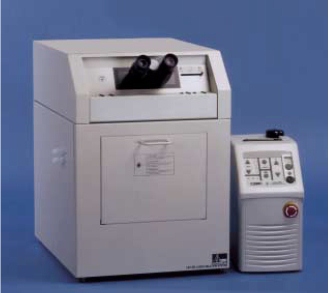|
Instrument Database:
Teledyne CETAC Technologies - LSX-200 Plus - Laser ablation system
| |
|

|
| |
|
| |
|
| Year of introduction |
2001 |
| Status |
historical ( out of sale ) |
| Company |
Teledyne CETAC Technologies
|
| Categories |
Sample introduction: Laser ablation
|
|
The LSX-200 Plus Laser Ablation System provides the latest innovation in solid sampling technology. The laser is designed to produce a Flat-Top beam profile. One major advantage of the beam profile is that a truly uniform energy distribution with each laser pulse is directed onto the sample surface. This results in especially clean and coherent ablations that ensure excellent crater characteristics in the sample matrix. High-energy ablations generate a dense aerosol (<1 µm in nonuniform particles) that is carried into the plasma. Importantly, the amount of analytically useful aerosol is dependent upon several factors: crater diameter, pulse repetition rate and laser energy. The LSX-200 Plus system offers full control of these parameters providing optimum perfomrance for each application. The parameters can be tailored to suit desired sensitivity, crater characteristics and application requirements. Coupling this with a superior optical system which offers magnification from 80-800X, controlled illumination and precise focus control gives the analyst maximum flexibility. A direct viewing petrographic microscope system incorporating dual polarizers, is optionally available, for more optically demanding samples and applications. The ablation chamber plays an important role in the stability of the analytical signal. Specially designed sample cells are available in four (4) different models (Figure 3). In addition, these include an oversize cell, pharmaceutical cell and a universal thin-section cell. Each cell is suited and tested for particular application requirements. The LSX-200 Plus system does not incorporate a space limiting sample cassette holder. Rather, the system was designed to house samples as large as 10 cm x 4 cm x 4 cm and has the capability to sample a 8.5 x 11” sheet of paper. Cell volume and system dead volume is often a factor in sensitivity and signal stability. It is desired to use the well-tested standard LSX-200 Plus ablation cell since it is proven to increase the amount of aerosol that is actually transported to the plasma for analysis. Cell volume can be optimized by using different sample holders for each application. The universal thin-section holder is used for optically thinsections as long as 55 mm with a standard width of 27 mm (as in an ion microprobe section). These samples can be viewed with reflected or transmitted light. The LSX-200 Plus incorporates high quality software controlled polarizers that are easily crossed in 10 degree increments (see Figure 4 showing the sample image of an andradite garnet thin-section).
|
| Specifications |
|
|
Laser
- � Frequency quadrupled, Q-switched Nd:YAG laser, 266
- nm
- � 6.0 mJ/pulse laser energy, 1% RSD RMS, computer
- controlled
- � Flat-Top laser beam energy profile
- � Laser pulse width: < 4 ns
- � Repetition rate: 1-20 Hz
- Optical Imaging control system�
- Switching optic for gaussian and flat beam sampling�
- Q-switch controlled laser frequency selection
- Built in laser energy measurement system�
- 5X, UV achromatic objective lens (10x Optional)�
- Variable spot sizes, digital aperture system: 10-300 µm, 5-150 um, calibration not required
Viewing Optics and Video System
- �Coaxial viewing and laser focus optics with a single lens (option)
- �Computer-controlled, continuously adjustable parfocal
- video microscope from 80X-800X
- �Motorized zoom video camera
- �Fiber optic illuminators with two 150 W lamps
- �Reflected and transmitted light illumination
- �Manual and computer control focusing
- �Image integration on host computer using high resolution video card
Sampling System
- 52 mm diameter X 50 mm high sample cell (104 mm travel axis optional)
- Stepper motor control integration on host computer using high speed stepper control card
- Motorized XYZ translation stage, 52 mm travel axis, 0.25 micrometer resolution, 1 micrometer steps
- �3-stage motor drivers with manual override
- �Adaptable volume, Teflon and viton construction
- �Automated purge, by-pass or to ICP gas control
- �Oversize sample cell 10 x 4 x 4 cm (optional)
- �Universal thin-section and microprobe standard sample holder
- �Custom integrated software control for segmented line scans
- �Flexible focus control, automated or manual
- Ablation cell with removable quartz window for easy cleaning and maintenance
- �Extendible sampling stage for easy sample installation
Computer hardware and software
- Integrated laser system control software with ICP or ICP-MS host computer
- DigiLaz TM Software, Digital Operating System
- �WindowsTM NT based software
- �On screen display of safety interlocks and laser status including laser firing, door open, coolant temp and flow
- �Universal communication protocol for synchronization of ICP-MS and laser systems
- �7 laser ablation methods and scan control with point to point, traverse, raster and gradient profiling
- �Method file management
- �Spot size measurement
- �Image capturing
- �On-line help, service, maintenance databases
- �Automated control of output energy indicator
- �Single shot or automated repetition
- �Computer controlled spot size
- �Automated video zoom and sample motion control
- �Superior depth profile software control <0.25 ìm
System
- �Dimensions: Laser Module 45 x 59 x 60 cm
- Power supply 20 x 30 x 37 cm
- Weight: 55 kg
- �Power requirement: 100-250 VAC +/- 10%
- �Class 1 enclosure with safety interlocks
- �Independent programmable laser power supply module
- �Closed loop distilled water cooling system
Options
- Geo-option: includes binocular direct viewing with variable magnification, computer controlled polarizing light with thin section holder
- �Sample Auto-focus
- �Custom software integration of external programs
- �GeoProTM data handling and manipulation software for time resolved analysis
- �Pentium computer system w/19” monitor
|
|